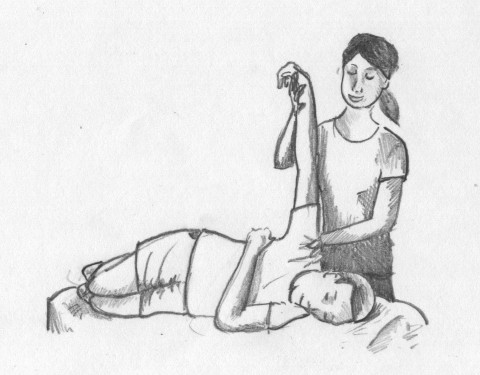
To any Connecticut College athlete who frequents the athletic training room down at the Athletic Center, the hustle and bustle met upon opening the door is to be expected- especially in the weekday rush hour from 3:15 pm to 4:15 pm. Scores of different athletes pour in and out of the cozy room, utilizing cold laser and ultra sound machines, heating and icing different muscles, taping various body parts, delving into both hot and cold whirl pools, and undergoing painful Grasden treatment. At the center of all the activity, along with counterparts John Heck and Cathy Horne, is beloved trainer Dale Robinson-Gervais.
Dale has been working at CC for about seventeen years. When asked why she decided to get into the field of athletic training, Dale responds that many factors “have made the job ‘fit’ over the years,” even her early childhood.
Raised on a farm, Dale learned “all about team work and work ethic right there. I learned too, how much fun it is to become physically skillful and how easy it is to wreck yourself when you get faster, stronger, and more daring.” Reminiscing on her childhood, Dale says she “pulled a million crazy capers I won’t tell you about that should have killed us as kids.”
“A lot of people in my family were involved in medicine and I was always interested in that. I remember seeing injuries at hockey games my brothers played in and thinking I should know how to fix them,” she says.
Prior to gaining her degree at the University of Connecticut, Dale broke racehorses to make serviceable hunters and jumpers. Working with live animals, “injuries were very real and sometimes very bad.”
Dale also spent some time as a children’s gymnastics coach, but it wasn’t the “kind of challenge” she was looking for. Eventually, she decided to become a trainer.
“Athletic training provided the opportunity to use a little grey matter in helping other people get back into doing what they love,” Dale says. “The medical field is changing all the time and lends itself to constant learning. I love problem solving.”
As anyone who knows Dale would attest to, her job is certainly not easy. The hardest parts of being a trainer, she says, is “seeing someone in severe or chronic pain and knowing I can’t fix it; finding it in myself to treat the fortieth athlete of the day with the same attention and care as I give the first one; standing in the sleet, rain, wind, or freezing cold, and giving up much time with my family.”
She continues, saying, “I try to do two things in my work: to show every person great respect, and to teach people how to deal with adversity.” Modestly, Dale mentions that she is “not always successful, and Cathy and John can probably attest to my being as cranky as anyone they know. But the truth is, it’s a great feeling to get your own puny egocentric self out of the way once in awhile and see what little bit you can do to make life a little easier for someone else.”
Dale certainly does that. She has the uncanny ability to make you feel as though you are the only wounded athlete in the room, as chaotic and crowded as it may (and probably will) be on any given day. She focuses in on the injury at hand, making sure to heal not just physical, but mental wounds as well. Somehow, she is able to remember not just the names of all her frequent visitors, but to also really get to know them all on a personal level. Having an injury is one of the most frustrating instances that an athlete encounters, and Dale combines an amazing amount of empathy with a rare ability to make athletes feel better, even if their injuries are painful and chronic.
Dale rewards her athletes with her knowledge, patience, and care. But for Dale, her profession is a two-way street. She is able to list numerous rewards she reaps from her job every day.
“That athlete that comes in with a chip on his shoulder and leaves smiling; or the one with a demanding whine that learns to let someone else go first; or the athlete that blows me away with all their dedication and learns to take care of themselves so well that they come to me with a plan for their workout that I couldn’t shoot holes through if I wanted to. And this: that beautiful day on the field when a badly injured, well disciplined patient forgets for the first time to flinch or hesitate or favor that old injury they worked so hard to get over, and is just in the flow of the game using the skills they know so well and love so much.”
“Going home to see my grandchildren ain’t so bad, either,” adds the smiling trainer as a good-natured afterthought.
As the last of the fall sports wrap up and the winter teams begin to practice, a new crew of athletes begin to dominate rush hour in the trainer’s room. However, one thing remains constant. Like always, Dale is in the trainer’s room, around the athletic center, and on the fields, perpetually helping CC athletes get healthy, stay healthy, and do what they love. •








